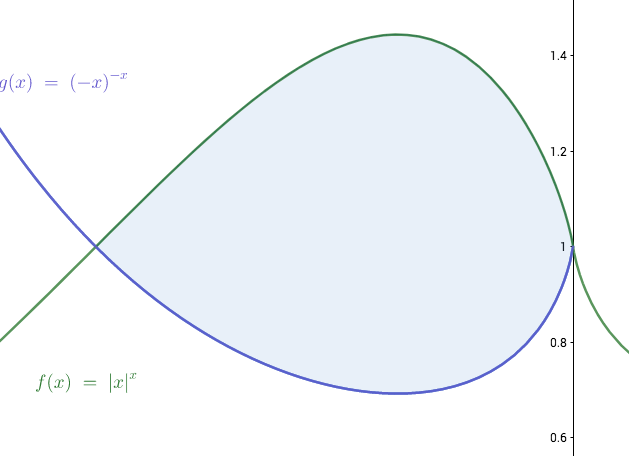Sophomore's Leaf
It is a fairly well-known property that is impossible to evaluate using standard mathematical functions.
Let
and
.
Let
be the area of the region bounded by
and
.
Determine
.

The answer is 50785.
This section requires Javascript.
You are seeing this because something didn't load right. We suggest you, (a) try
refreshing the page, (b) enabling javascript if it is disabled on your browser and,
finally, (c)
loading the
non-javascript version of this page
. We're sorry about the hassle.
We can make x = − x and take the positive side, for simplicty. The intersection points will be 0 and 1 and, since x is positive, ∣ x ∣ = x . Thus, this becomes:
A = ∫ 0 1 ( x − x − x x ) d x
A = ∫ 0 1 e − x ln ( x ) d x − ∫ 0 1 e x ln ( x ) d x
A = ∫ 0 1 k = 0 ∑ ∞ k ! 1 [ − x ln ( x ) ] k d x − ∫ 0 1 k = 0 ∑ ∞ k ! 1 [ x ln ( x ) ] k d x
A = k = 0 ∑ ∞ k ! 1 [ ∫ 0 1 [ − x ln ( x ) ] k d x − ∫ 0 1 [ x ln ( x ) ] k d x ]
Make u = − ln ( x ) on both integrals. Then, x = e − u and d x = − e − u d u :
A = k = 0 ∑ ∞ k ! 1 [ ∫ 0 ∞ e − u ( k + 1 ) u k d u − ( − 1 ) k ∫ 0 ∞ e − u ( k + 1 ) u k d u ]
A = k = 0 ∑ ∞ k ! 1 − ( − 1 ) k [ ∫ 0 ∞ e − u ( k + 1 ) u k d u ]
Multuply above and below by ( k + 1 ) k :
A = k = 0 ∑ ∞ k ! ( k + 1 ) k 1 − ( − 1 ) k [ ∫ 0 ∞ e − u ( k + 1 ) [ u ( k + 1 ) ] k d u ]
Make t = u ( k + 1 ) . Then, d t = d u ( k + 1 ) :
A = k = 0 ∑ ∞ k ! ( k + 1 ) k 1 − ( − 1 ) k ⋅ k + 1 1 [ ∫ 0 ∞ e − t t k d t ]
The integral is the exact definiton of Γ ( k + 1 ) , which is equal to k ! :
A = k = 0 ∑ ∞ k ! ( k + 1 ) k + 1 1 − ( − 1 ) k ⋅ k !
A = k = 0 ∑ ∞ ( k + 1 ) k + 1 1 − ( − 1 ) k
Make n = k + 1 :
A = n = 1 ∑ ∞ n n 1 − ( − 1 ) n − 1
The numerator will be 0 for odd n and 2 for even n . Thus:
A = n = 1 ∑ ∞ ( 2 n ) 2 n 2
This sum quickly converges ( 5 steps) to:
A = 0 . 5 0 7 8 5 5 4 8 6
Correct to 9 decimal places. Thus:
⌊ A ⌋ = 5 0 7 8 5